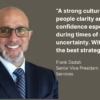
Autumn is a reflective time for me. This time of year is a good time to think about change. The leaves are changing. The air is changing. School is starting, which is always a change. I like to take stock of what has happened over the past year and look ahead to the months and year to come. As I thought about the passage of this year, my first with MCG Partners, I also remembered that this is often a time of change for our clients. They are taking the same reflective stance.
You may be thinking about your 2014 budget and projects. Or, you may be preparing for changes to your benefits plans as a result of the Affordable Care Act. Perhaps the last quarter is your busiest time of year; perhaps it is your slowest. Regardless of the origin, you can feel the restless energy of change in the air.
Change can be exhilarating and exhausting at the same time for the same person. Or perceived as a challenge to overcome by one person and an obstacle to avoid by another. The number of emotions and reactions are as varied as the people experiencing them. So, how can you lead your organization through times of change?
One strategy is to understand how our natural styles can act as enablers and barriers to change. MCG Partners can support your organization through change by helping you understand your natural tendencies and the natural tendencies of your team. Using this information, you can develop plans and actions that will better leverage the natural strength and resiliency we all possess.
Another strategy is to plan change. Research by John Kotter shows that up to 70 percent of all major change efforts in organizations fail. [1] There are countless strategies, models, tools and tips for managing change.
The Compass for Change™ model that we use to help clients plan change combines five essential elements into an easy to remember visual model that is conceptual and flexible, rather than linear and prescriptive.

Central to successful change is Strategic Vision and Alignment. As the Cheshire Cat advised Alice, the way she ought to go “depends a good deal on where you want to get to.” In addition to knowing where you are going, everyone needs to be onboard and willing to go the same direction.
To the north is Stakeholder Identification. Who are your internal stakeholders? Who are your external stakeholders? How will this change impact your stakeholders directly? How will it impact them indirectly? How will potential changes made by them in response to your change effort effect you?
At the south pole is Readiness. How will you know your stakeholders are prepared for the changes? How will you check the pulse and temperature of the organization or of your own team?
Two key mechanisms for facilitating change, Training/Communication and Engagement/Involvement, are found to the east and west. Is the change happening through people or to people? People are much more likely to change and to champion change when they are involved in the change process. That doesn’t mean leading change by committee. Rather, it means looking at all the ways people can be involved, informed, engaged, and allowed some level of control and input over the change. It can be as simple as being asked to participate in a focus group to as complex as being identified as the change lead.
We see so many organizations that think change management means providing training and having a communication plan. Those are valid and necessary strategies but not all encompassing. How can you involve your stakeholders in the training? Is becoming a temporary trainer or subject matter expert an opportunity for a stretch assignment? How can you foster two-way communication throughout the change? If you’ve told everyone what you know, have you told them what you don’t know? How transparent can you be?
We have leveraged this model to great success. We’ve been involved in industry-leading results that led a client to recover productivity more quickly than expected, which enabled us to speed up the timeline for the remaining implementation efforts. More importantly, we transformed the culture from one of independently functioning units to a more collaborative environment where colleagues shared challenges, ideas and best practices freely.
If you are preparing for a change initiative in your organization, let MCG Partners and the Compass for Change help you reach your destination.
[1] Kotter International






